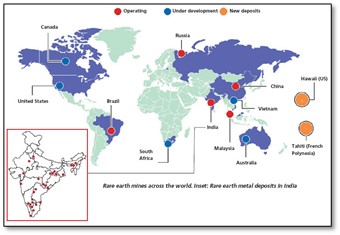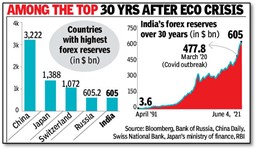Friday, 18th June 2021
World Competitiveness Index 2021
In News
The Institute for Management Development (IMD) has released the World Competitiveness Index 2021.
About the News
- India maintained 43rd rank on an annual World Competitiveness Index, which examined the impact of COVID-19 on economies around the world this year.
- Among the BRICS nations, India is ranked second after China (16), followed by Russia (45th), Brazil (57th) and South Africa (62th).
- Innovation, digitalization, welfare benefits, and social cohesion are key to economic performance in the 2021 rankings, topped with Switzerland (1st), Sweden (2nd) and Denmark (3rd).
- The top-performing economies are characterised by varying degrees of investment in innovation, diversified economic activities, and supportive public policy. Competitive economies succeeded in transitioning to a remote work routine while also allowing remote learning. Addressing unemployment has been fundamental.
About the Index
- The ranking, produced annually by the IMD World Competitiveness Centre, measures the prosperity and competitiveness of 64 nations by examining four factors -- economic performance, government efficiency, business efficiency, and infrastructure.
- It provides benchmarking and trends, as well as statistics and survey data based on extensive research. It analyzes and ranks countries according to how they manage their competencies to achieve long-term value creation.
India’s Performance
India's improvements in the government efficiency factor are mostly due to relatively stable public finances (despite difficulties brought by the pandemic, in 2020 the government deficit stayed at 7 per cent) and to the positive feedbacks we registered among Indian business executives with respect to the support and subsidies provided by the government to the private companies. The short term performance of India's economy will depend on its ability to address the pandemic.
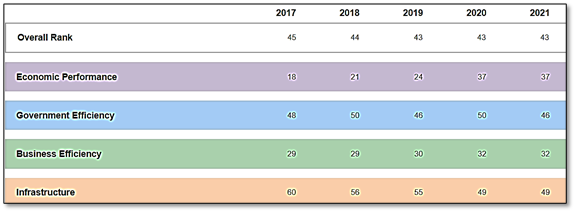
Sources: https://www.imd.org/centers/world-competitiveness-center/rankings/world-competitiveness/
Inland Vessels Bill, 2021
In News
The Union Cabinet approved the Inland Vessels Bill, 2021, which will replace the Inland Vessels Act, 1917.
Features of the Bill
- About the Bill: It will lay down a framework addressing the changes under the current system and delegate the Central and State Governments the authority to prescribe rules, standards in accordance with the specific provisions of the bill.
- Unified Law: A key feature of the Bill is a unified law for the entire country, instead of separate rules framed by the States. The certificate of registration granted under the proposed law will be deemed to be valid in all States and Union Territories.
- Central data base: For recording the details of vessel, vessel registration, crew on an electronic portal. It requires all mechanically propelled vessels to be mandatorily registered. All non-mechanically propelled vessels will also have to be enrolled at district, taluk or panchayat or village level.
- Inland waters: Inland waters for the purpose of inland navigation, include canal, river, lake or other navigable water inward, tidal water limit, national waterways declared by the Central Government and other waters as may be declared by the Central Government
- Pollution control measures of Inland Vessels: This bill directs the Central Government to designate a list of chemicals, substances etc. as pollutants. Pollution certificate shall be issued for the mechanically propelled vehicles and the Reception facilities, containment of pollution shall be as prescribed by the Central Government.
- Wreck and Salvage: The Bill puts the onus on the owner, operator, master or person in charge of a vessel plying in inland waters to not abandon, desert, dump, throw overboard or jettison the vessel or property or parts or cargo so as to cause wreck.
Significance of the Bill for Inland Waterways in India
- India has an extensive network of inland waterways in the form of rivers, canals, backwaters and creeks. A total of 4,000 kilometres of inland waterways are operational. The Cabinet has approved the Inland vessel bill to ensure the safety, security of vessels running on waterways, besides seeing that their registration is done smoothly.
- The bill addresses the quintessential need for reform as per new standards of safety and environment regulation as well as equally addressing the current technology changes.
Sources: https://www.thehindu.com/news/national/cabinet-nod-for-inland-vessels-bill/article34832506.ece
Commodity market facing cyclical recovery
In News
From early 2021, prices of many commodities — energy products, various metals and agriculture — have escalated to high levels.
What is Commodity Market?
- The term commodity refers to any material, which can be bought and sold. Commodities in a market’s context refer to any movable property other than actionable claims, money and securities.
- Commodity market refers to markets that trade in primary (i.e., commodities) rather than manufactured products.
- The commodities traded in the Indian commodity derivative markets are usually classified into four segments. These are as follows: Agricultural Commodities(soybean, cotton, Palm Oil etc.), Bullion and Gems(gold, silver etc.), Energy commodities (Crude oil, natural gas etc.) and Metal commodities (copper, brass, iron, steel, etc.).
- MCX, ICEX, NCDEX etc. are some of the popular Commodity Exchanges in India to trade. Securities and Exchange Board of India (SEBI) regulates the commodity derivatives market in India.
Current Trends in Global Commodity Markets
- The pandemic-related lockdowns led to massive demand destruction in 2020 and business confidence turned weak. Fresh investment in productive capacities declined. This has negatively impacted the commodity trading.
- There is now a surge in demand, especially with China leading the way with rising consumption of commodities to feed its growth needs.
- Globally, commodity markets have rallied since the last quarter of 2020. Prices of crude oil (Brent), industrial metals (copper), gold, cotton and palm oil have all gained by anything between 50% and 100% from a year ago levels. This is being termed as cyclical recovery of commodity market.
Reasons for Cyclical Recovery in Commodity Markets
- Prospect of improved economic growth in 2021 and beyond especially after large-scale immunisation against Covid in many developed countries is boosting the sentiment and building confidence among market participants.
- Geopolitics: Although not alarming, geopolitical tensions on the one hand, and improving demand on the other, are seen keeping the energy market buoyant. OPEC+ continues keeping production of crude oil restrained as per agreement. Sanctions on Iran due to its nuclear programme are still in place.
- Monetary Policy: Led by the US Federal Reserve, central banks around the world are loosening their monetary policy, expanding liquidity and dropping interest rates in order to revive their economies. A part of the low-cost money finds its way into the commodities market.
- Currency dynamics: The US dollar has depreciated in the last one year, especially against the euro. A weaker dollar propels the prices of commodities.
- Weather and Climatic Factors: La Nina weather phenomenon has impacted agriculture since the last quarter of 2020. While South Asia and Southeast Asia received more than normal rainfall, South America faced dry weather conditions.
- Harvests of sugarcane, soybean, corn and other crops faced shortfall due to dry weather in Brazil and Argentina. This has sent agricultural markets spiralling up in the first half of 2021.
Reference
https://www.sebi.gov.in/sebi_data/faqfiles/aug-2020/1596600172449.pdf
https://gfgc.kar.nic.in/gauribidanur/FileHandler/59-29af45eb-0af0-4d7e-b30c-62721fbbffa0.pdf
https://www.angelbroking.com/knowledge-center/commodities-trading/what-is-commodity-market
Aspirational Districts Programme
In News
The United Nations Development Programme (UNDP) has lauded the Centre’s Aspirational Districts Programme (ADP), saying that it should serve as a “best practice” for other countries where regional disparities in development status persist for many reasons.
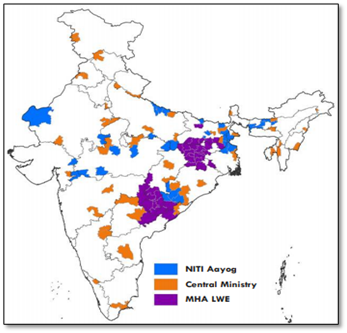
What are Aspirational Districts?
- Aspirational Districts are those districts in India that are faring poorly in health, education, skill development, etc. Most Aspirational Districts are located in remote areas, and some even plagued with Left Wing Extremist (LWE) conflicts. These factors continue to hinder their growth and make it more difficult for any development programmes to be implemented.
- A total of 117 Aspirational districts have been identified by NITI Aayog.
About the Aspirational Districts Programme (ADP)
- Launched in the year 2018, the Aspirational Districts’ programme aims to quickly and effectively transform these districts. The broad contours of the programme are Convergence (of Central & State Schemes), Collaboration (of Central, State level ‘Prabhari’ Officers & District Collectors), and Competition among districts driven by a mass Movement.
- Institutional Structure: The Aspirational Districts Programme focuses on five critical sectors (weightage) – i.e. Healthcare (30%), Education (30%), Agriculture & Water Resources (20%), Financial Inclusion and Skill Development (10%) and Basic Infrastructure (10%).
- Performance Indicators: 49 key performance indicators have been chosen to measure progress of the districts. Districts are prodded and encouraged to first catch-up with the best district within their state, and subsequently aspire to become one of the best in the country, by competing with, and learning from others in the spirit of competitive & cooperative federalism.
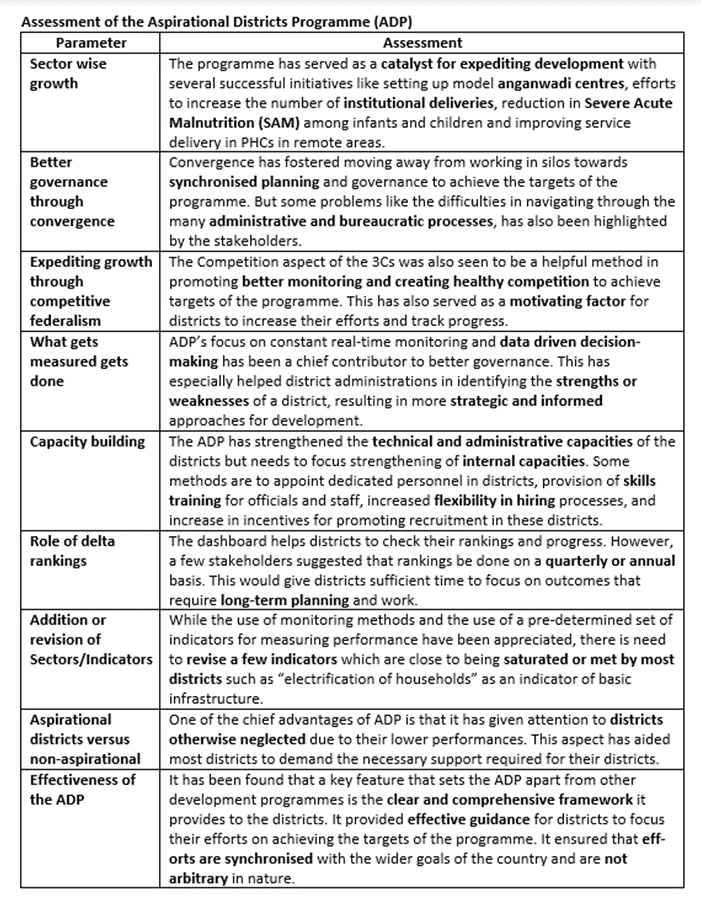
Way Forward to counter some challenges
- Disparities among districts: One of the disadvantages of the Aspirational Districts has been the disparities among districts which does not facilitate fair competition and comparisons. In order to counter these issues, districts could be further grouped together based on their common characteristics and be supported accordingly.
- Data discrepancies and adverse effects of competition: The commencement of ADP brought with it few challenges relating to monitoring and data collection, one of which is the discrepancy in data collected and recorded. Discussions with different stakeholders have highlighted the need for revising indicators, as well as reduced focus on a competitive approach, as they are likely to result in misreporting of data by districts.
- Scope for collaboration: Given the disparities in sectors, districts and also capacities, furthering collaboration with different organisations may provide the immediate and required support to districts. This can especially be provided for districts located in remote and challenging areas.
- Addition of sectors or themes: One of the suggestions is to include additional sectors or themes cantered around key topics of environment and gender. This, according to the stakeholders, should not just be targeted for the beneficiaries of the programmes, but also integrated within the governance model as indicators of inclusive and sustainable growth.
Question: What is the Aspirational district Programme? Examine its progress in brief.
This Day in History - Rani Lakshmibai
On June 18th, 1858, Rani Lakshmibai of Jhansi, one of the most important figures of India’s First War of Independence, died while fighting against the British in Gwalior. Maharani Lakshmibai is regarded as one of the leading figures of India’s rebellion in 1857 against the British, which is also referred to as the first war of independence. She was widely regarded as India’s “Joan of Arc,". Born in 1828 into a Maharashtrian family in Varanasi, Maharani Lakshmibai was initially named Manikarnika Tambe. Her father, Moropant Tambe worked for Peshwa Baji Rao II of Bithoor district. Manikarnika was educated at home and was also taught shooting, fencing, mallakhamb and horsemanship. She was married to Gangadhar Rao Newalkar, the Maharaja of Jhansi, in 1842.
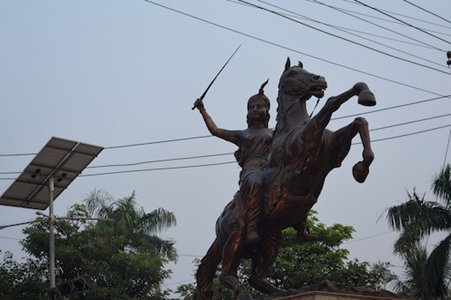
Image of the Day- Mud puddling
This is the image of activity called Mud puddling. Under this activity butterflies congregate around mud, dung, water etc. to suck up the much-required fluids and salt. This behaviour is shown mostly by the males. They collect salts and pheromones to attract females. This activity usually takes place in the early morning hours or at the onset of dusk. Damp sandy areas and mud banks are their areas of choice for this behaviour. If left undisturbed, these butterflies often tend to spend hours on the damp patches.
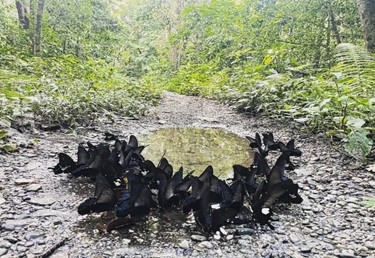
ASEAN Defense Ministers Meeting (ADMM) Plus
- Context: Open & inclusive order in the Indo-Pacific has been called for at the 8th ADMM Plus.
- The ADMM-Plus is an annual meeting of Defence Ministers of 10 ASEAN countries and its eight Dialogue Partners- Australia, China, India, Japan, New Zealand, Republic of Korea, Russian Federation and the United States.
- It promotes mutual trust and confidence between defence establishments through greater dialogue and transparency and aims to strengthen security and defence cooperation for peace, stability, and development in the region.
- Its areas of cooperation include maritime security, counterterrorism, humanitarian assistance and disaster relief, peacekeeping operations and military medicine.
- ADMM Plus is chaired by Brunei this year. The inaugural ADMM-Plus was convened in Ha Noi, Viet Nam, on 12 October 2010.
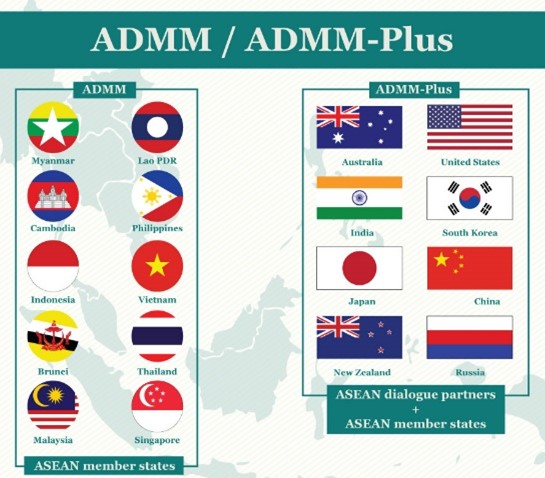
Primary source: https://asean.org/asean-political-security-community/asean-defence-ministers-meeting-admm/
Picture source: https://theaseanpost.com/article/asean-approach-counter-terrorism
Hallmarking of Gold
- Context: the government has announced the phased implementation of mandatory hallmarking of gold jewellery.
- The Bureau of Indian Standard (BIS), which operates gold and silver hallmarking scheme in India, defines hallmarking as the “accurate determination and official recording of the proportionate content of precious metal in precious metal articles.”
- Therefore, it is a “guarantee of purity or fineness” of precious metal articles.
- Hallmarking in India is available for jewellery of only two metals-gold and silver.
- The BIS certified jewelerscan get their jewellery hallmarked from any of the BIS recognized Assaying and Hallmarking Centres (A&HC).
- The level of hallmarked jewellery is very low (30%) in India albeit India being the biggest consumer of gold, reason being non-availability of sufficient A&HC across the country.

Primary source: https://indianexpress.com/article/explained/what-is-gold-hallmarking-list-of-districts-where-it-is-mandatory-7361818/
Picture Source: https://www.dailyexcelsior.com/gold-to-be-mandatory-hallmarked/
Direct Tax
- Context: Direct tax collections surge in 2021-22.
- Direct tax is a type of tax where the incidence and impact of taxation fall on the same entity. The burden of paying tax cannot be shifted to someone else.
- Income tax, corporation tax, property tax, inheritance tax and gift tax are examples of direct tax.
- Direct taxes in India are overseen by the Central Board of Direct Taxes (CBDT).
- India’s direct tax collections in the first two and a half months of 2021-22 stand at nearly ₹1.86 lakh crore, double the collections over the same period of last year. The jump in the direct tax collections reflects healthy exports and a continuation of various industrial and construction activities.
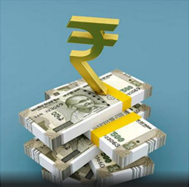
Primary source: https://economictimes.indiatimes.com/definition/direct-tax
https://www.business-standard.com/about/what-is-direct-tax
Picture Source: https://www.thehindu.com/business/Economy/direct-tax-collections-surge-in-2021-22/article34831432.ece
A place for disruptive technology in India’s health sector
Essence: As frontline warriors fighting COVID 19 have been exposed to great risk, the relevance of disruptive technology and its applications comes into focus, potentially helping to reduce the chances of hospital staff contracting the infection. In this context, the article discusses how new technologies can improve the welfare of societies and reduce the impact of communicable diseases, thereby improving the health sector in general.
Why you should read this article?
- Have a list of few examples on the use of the innovative technologies in health sector.
- Understand the importance of technologies such as artificial intelligence (AI), autonomous systems, blockchain, cloud and quantum computing, data analytics, 5G in the transformation of the health sector.
- Understand how UHC can be achieved through the application of digital technologies, led by a robust strategy integrating human, fi nancial, organisational and technological resources.
- Know about the importance of an effective national response which draws upon local knowledge.
- Identify the possible challenges and measures to overcome them.
Article Link: https://www.thehindu.com/opinion/lead/a-place-for-disruptive-technology-in-indias-health-sector/article34844095.ece
Has the blackbox of UAPA finally been opened?
Essence: Editorial is highlighting the importance of recent decision of bail order in UAPA case. There has been continuous contention on usage of certain provisions of UAPA to suppress the dissent. The definition of “terrorism” in Section 15 of the UAPA is vague, and has been used as a licence to classify all kinds of infractions as terrorist. This order also helpfully points out that a simple law-and-order problem in a state should not be equated with a terrorist problem. By making a clear distinction that the former is a state subject, and the latter a Union subject under lists one and two, the order, potentially, also has implications for federalism in matters of law enforcement. This order is also a welcome effort to prevent our civil liberties from being swallowed up by the black hole of state power.
Why you should read this article?
- To understand the debate around application of UAPA & vagueness in some provisions.
- To know about the larger implication of recent court order on bail, by setting right context of law.
- It is also providing insights into link between judicial interpretation of UAPA & civil liberties.
Article Link: https://indianexpress.com/article/opinion/columns/has-the-blackbox-of-uapa-finally-been-opened-7363965/
Dr. Mapuskar – A Life Dedicated To Improving Rural Sanitation In India
- One individual can bring a lot of change with his or her efforts is highlighted by the story of Dr. Mapuskar.
- He worked relentlessly to ensure that a high level of hygiene and sanitation in rural areas.
- He advocated the use of decentralised, low-cost sanitation in rural areas:
How did the story begin:
- He shifted for work in rural areas and the hospital where he was working did not have a toilet.
- As a doctor in the village, he witnessed only a handful of illnesses – all hygiene related.
- He went a long way to convince the villagers of the importance of toilets and built the toilets on no-profit-no-loss principle.
Methodology deployed to convince the villagers:
- He created a massive awareness campaigns, household visits, group discussions, experimentation with technology, planning and executing projects by mobilizing the community and making them stakeholders.
Where can we use this case study:
- Medical ethics goes a lot beyond simply treating people, social persuasion to bring a change in the behaviour.
Things to ponder:
- How to bring attitudinal change in oneself and others.
Share the article
Get Latest Updates on Offers, Event dates, and free Mentorship sessions.

Get in touch with our Expert Academic Counsellors 👋
FAQs
UPSC Daily Current Affairs focuses on learning current events on a daily basis. An aspirant needs to study regular and updated information about current events, news, and relevant topics that are important for UPSC aspirants. It covers national and international affairs, government policies, socio-economic issues, science and technology advancements, and more.
UPSC Daily Current Affairs provides aspirants with a concise and comprehensive overview of the latest happenings and developments across various fields. It helps aspirants stay updated with current affairs and provides them with valuable insights and analysis, which are essential for answering questions in the UPSC examinations. It enhances their knowledge, analytical skills, and ability to connect current affairs with the UPSC syllabus.
UPSC Daily Current Affairs covers a wide range of topics, including politics, economics, science and technology, environment, social issues, governance, international relations, and more. It offers news summaries, in-depth analyses, editorials, opinion pieces, and relevant study materials. It also provides practice questions and quizzes to help aspirants test their understanding of current affairs.
Edukemy's UPSC Daily Current Affairs can be accessed through:
- UPSC Daily Current Affairs can be accessed through Current Affairs tab at the top of the Main Page of Edukemy.
- Edukemy Mobile app: The Daily Current Affairs can also be access through Edukemy Mobile App.
- Social media: Follow Edukemy’s official social media accounts or pages that provide UPSC Daily Current Affairs updates, including Facebook, Twitter, or Telegram channels.



